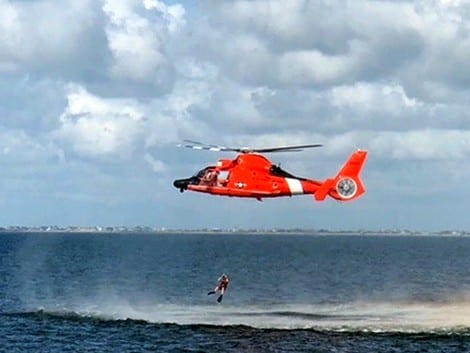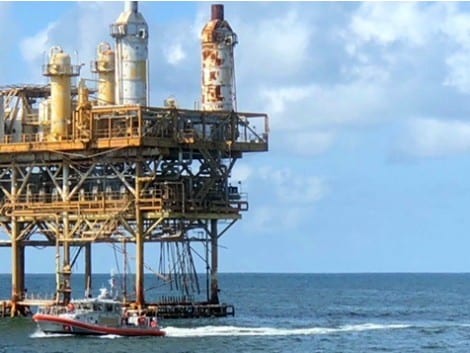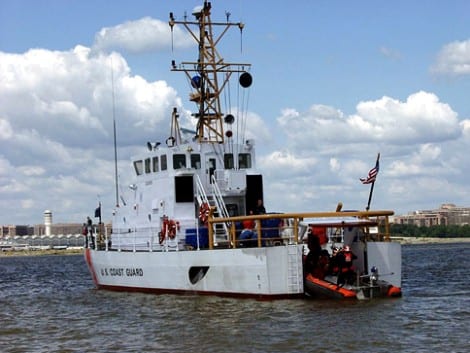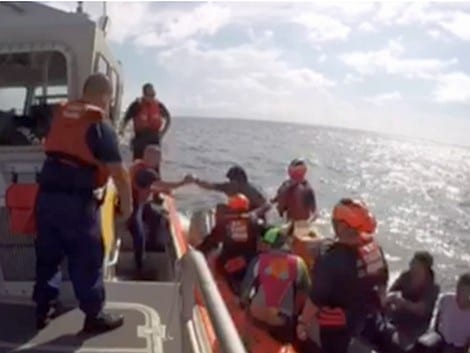 By Bob Currie, Vessel Examiner
By Bob Currie, Vessel Examiner
United States Coast Guard Auxiliary Flotilla 081-06-08
Another Rescue at Sea
The Sector Houston-Galveston Watchstander received word of another capsized recreational vessel off Crystal Beach this weekend. The five occupants stayed with the capsized boat and were successfully rescued by US Coast Guard Cutter Seahorse, with assistance from an Air Station Houston helicopter and rescue swimmer. This is the third capsized vessel in recent weeks. In all three cases the vessel occupant were successfully rescued due to quick action from the Coast Guard and because the vessel occupants remained with the capsized boat. This may have been the first rescue participated by US Coast Guard Cutter Seahorse, an 87-foot Marine Protector Class patrol boat, since its arrival as replacement for the USCGC Manowar.
Flotilla 081-06-08 is based at Coast Guard Station Galveston. The Coast Guard Auxiliary is the uniformed civilian component of the US Coast Guard and supports the Coast Guard in nearly all mission areas. The Auxiliary was created by Congress in 1939. For more information, please visit www.cgaux.org.
Station Galveston also launched a 45-foot rapid response boat. A special thanks to Tanker Phoenix Vigor, inbound to Houston, for launching a boat to assist. The Sector Houston-Galveston Watchstander also diverted an Air Station Houston MH-65 Dolphin helicopter to the site, and a rescue swimmer entered the water to check on the persons clinging to the overturned hull. The Seahorse then recovered all five persons. The Seahorse then launched its small boat with the survivors aboard and they were transferred to the rapid response boat to be taken back to Galveston.

Rescue Swimmer Jumps from Helicopter (Photo Courtesy of US Coast Guard)

45-Foot Rapid Response Boat Arrives (Photo Courtesy of US Coast Guard)

Small Boat Launch from 87-Foot Patrol Boat (Photo Courtesy of US Coast Guard)

Survivors Transfer to 45-Foot Response Boat (Photo Courtesy of US Coast Guard)
Note from the picture above that none of the rescued persons were wearing life vests. They were extremely lucky that the Galveston County Sheriff’s Department received their call and quickly notified the Coast Guard. They were also lucky that Seahorse was underway and that the Coast Guard helicopter was already in the air. The overturned hull of the recreational vessel can just be seen at the very left of the picture of the rescue swimmer entering the water. A file photo shows an 87-foot patrol boat launching its small boat.
Operating Offshore
At some time, every boat and crew will encounter wind or sea conditions that challenge safe, successful boat operation. Due to size and design differences, extreme weather for one vessel is not necessarily challenging for another. Also, crew training, experience, and skill more often than not make the difference between safety and danger, regardless of the vessel.
Size, stability, and power are vessel characteristics that enhance safety and allow some forgiveness in large waves and high winds or due to the occasional lapse in skill or judgment. On the other hand, lightweight, speed, and agility give a means to avoid or to outrun conditions, but offer little protection or forgiveness for the slightest miscalculation. Caution should be used at all times. The power of winds and waves and what they can do to a vessel or crew should never be underestimated. Some boats are specifically made for operating on lakes and rivers, but should not be considered as appropriate for operating offshore.
Jon boats are one type of boat that does not work well as an offshore boat. Jon boats are easy to swamp when the waves break over the transom, and since they are not self-bailing like boats designed to be operated offshore, it is difficult to recover from the amount of water from even a single wave breaking over the transom. The only good thing that happened in the above accident is that air was trapped in the bow and the capsized boat continued to float. While a bay boat may work well in a calm bay, the waves encountered offshore are almost always more than such a boat can handle, and the consequences are often disastrous. Only boats designed for offshore use should venture out into the Gulf.
In order to operate successfully offshore, the boat operator must learn the vessel’s motions and peculiarities. Operate the vessel frequently and develop a working knowledge of its response to waves and winds. Excessive boat motion is very fatiguing and could cause motion sickness. Learn the motions the boat makes in response to varying sea conditions. Find out if the vessel has any distinctive tendencies, for instance, attaining a dangerous heel while cresting a wave in high winds, burying the bow in all but the longest swells, or “lightness” to the stern in quartering conditions. Learn and develop techniques to minimize vessel motion in all conditions. A small tweak of the throttle or a smooth helm-hand can make the ride much smoother and less fatiguing. On smaller vessels, keep passenger weight centered around the helm position. This is usually near the boat’s center of gravity. It will make the ride more comfortable for the passengers and will allow the hull to ride as designed. Many boats have recommended seating patterns that should be followed, especially when the water becomes rough. As Dirty Harry might have said had he been a recreational boater, “You have got to know your boat’s limitations.”
If you are going to operate offshore, in addition to having a boat designed for offshore operation you should:
- Always wear life jackets when underway.
- Have a marine/VHF radio with Digital Selective Calling (DSC) capability.
- Don’t overload the boat.
- Always file a float plan.
- Always check the weather and tides.
- Use charts and/or sonar and GPS.
- Always post a lookout to check for dangers such as submerged objects and other boats in order to avoid a collision.
- Follow the Rules of the Road.
Paddle Craft ID Stickers
Thanks to everyone who has requested a “Vessel Identification Sticker for Canoe, Kayak, SUP, or Rowboat” (also known as a Paddle Smart Sticker). By placing a Paddle Smart sticker on your paddle craft, you help the Coast Guard to quickly identify and contact you should your paddle craft be found on the beach or floating out on the water. By identifying and contacting the owner several thousand dollars can be saved if we don’t have to launch a search and rescue mission.
For more information on boating safety, please visit the Official Website of the U.S. Coast Guard’s Boating Safety Division at www.uscgboating.org. Questions about the US Coast Guard Auxiliary or our free Vessel Safety Check program may be directed to me at [email protected]. I am available to perform free Vessel Safety Checks, and I will come to your location to perform them. SAFE BOATING!
[9-10-2018]

 Posted in
Posted in 























